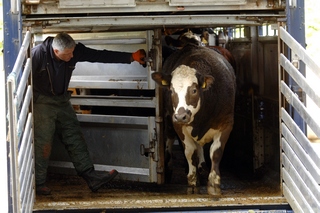DEFRA announces key foot and mouth and bluetongue strategy

DEFRA has today announced a number of key strategies, which include a risk-based approach to easing movement restrictions, in a bid to deal with the current foot and mouth and bluetongue disease situation.
From 3.30pm tomorrow (25 September) there will be two foot and mouth risk areas, as well as a Bluetongue Temporary Area (BTA), where different movement rules will apply, chief vet Debby Reynolds said.
The government’s decision to ease foot and mouth disease restrictions over a large part of England and Wales has been welcomed by the farming community.
However, the announcement of a new Temporary Control Zone on the Hampshire/Wiltshire border, just a short time after yesterdays Hampshire case emerged as being negative, reaffirms the need for the industry to remain vigilant.
Based on the latest epidemiological and veterinary information, DEFRA has decided to split the country into three risk areas for foot and mouth disease control purposes:
Area 1 – Protection and Surveillance Zone
Area 2 – Risk area: Surrey, Hampshire, Berkshire, West and East Sussex, Kent, Essex, Greater London, Hertfordshire, Buckinghamshire and Oxfordshire.
Area 3 – Low risk area – the remainder of Great Britain not covered by areas 1 & 2.

Movement controls within each area include:
Area 1 – Existing PZ and SZ controls will continue in these areas
Area 2 – Movements currently allowed will be allowed to continue. These include: Direct moves to slaughter; Direct movements to slaughter via collection centres and red markets; Calving cows (up to 50km with a 20 day standstill); and pigs moving within established pyramids. No movements out of the risk area to the lower risk area will be allowed and there will be no farm to farm movements.
Area 3 – Farm to farm movements will be allowed (from 3.30pm 25 September) subject to strict cleaning and disinfecting of vehicles, compliance with existing ID and movement rules. A signed self-declaration confirming the above and that the animals are free from signs of disease will also be required. More specific conditions are to be announced.
- The Bluetongue Temporary Area (BTA) will encompass: Suffolk, Lincolnshire, Nottinghamshire, Leicestershire, Cambridgeshire, Norfolk, Northamptonshire and Bedfordshire,
The same movement restrictions as in the foot and mouth risk zone will apply within the BTA, however farm to farm movements will be permitted under strict conditions.
No susceptible animals will be permitted to move out of the BTA, however there will be additional rules for pigs.
Debby Reynolds, chief vet, said: “All these areas will be kept under active review and we will continue with a risk-based, staged approach. The aim is to reduce the size of the foot and mouth disease risk area as work progresses.”
“In the next 24 hours everyone needs to prepare for their own role in ensuring this important next step is successful.”
Also published today was the latest foot and mouth Epidemiology report, which concluded that infected premises 5 (IP5) was actually IP3, and could provide the ‘missing link’ between the August and September outbreaks.
The report adds that the age of the lesions on cattle infected at IP5 suggested that, most probably, the farm was infected by “mechanical transmission”, whether from the Pirbright site or one of the first two infected farms.
